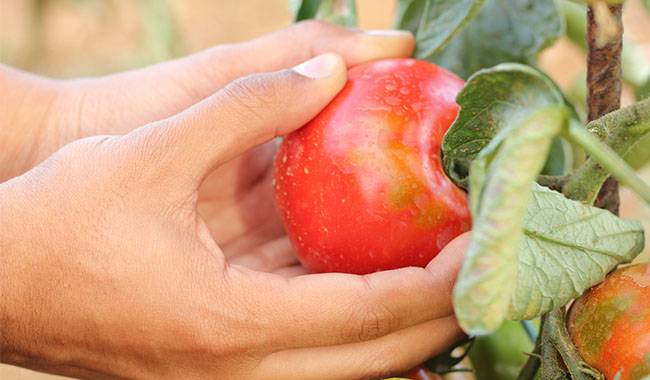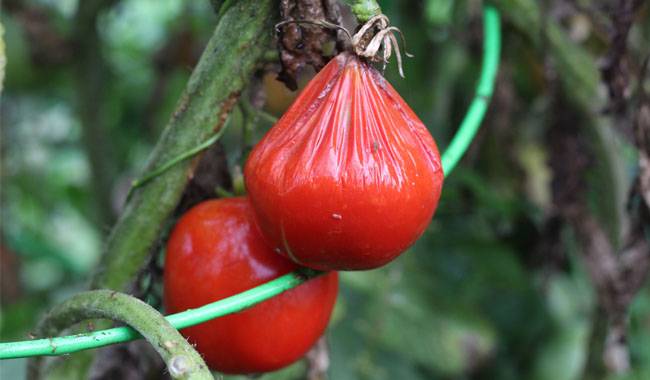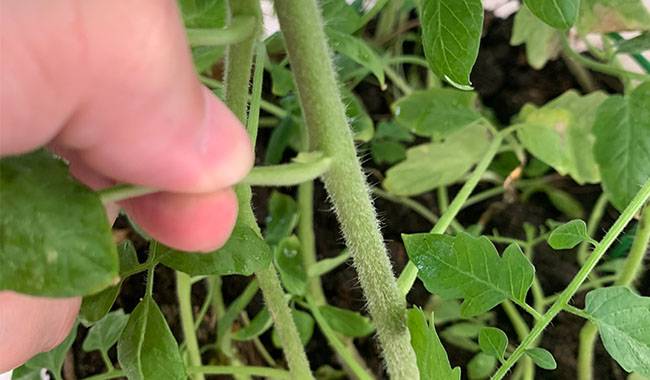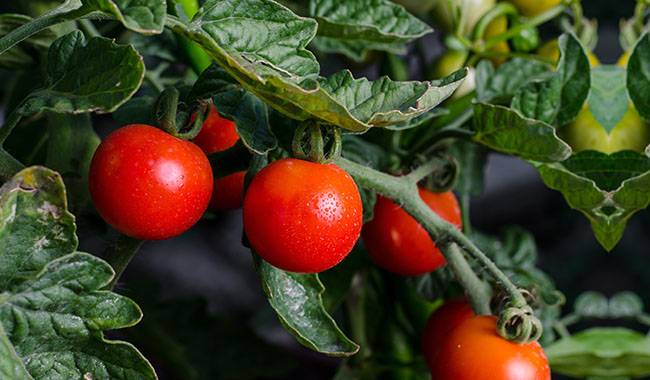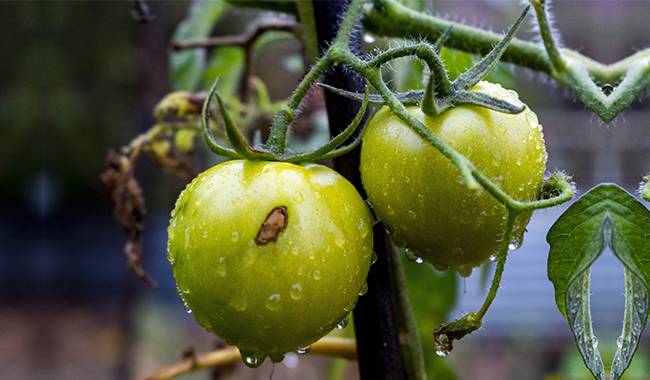
Tomatoes are a favorite vegetable in all regions of the world. Under optimal conditions, these amazing plants can flower and fruit year-round, providing a delicious, high-energy dietary fruit (berry) high in vitamins, trace elements, organic acids, and other compounds needed by humans.
Like all plants, tomatoes are susceptible to diseases that can change the flavor and quality of the fruit so much that they cannot be used for food. In addition, some diseases affect tomato plants, destroying all the work of the gardener within 1-2 days.
The causes related to tomato plant diseases are mainly due to non-compliance with the requirements of agronomic cultivation methods.
TYPES OF TOMATO DISEASES
Tomato diseases can be divided into two categories according to their effect on the plant.
- Non-infectious.
- Infectious.
Non-infectious tomato diseases are endemic. They do not spread to other plants, and if shortcomings in agronomic care are corrected, they recover and do not infect neighboring plants.
Violations of agronomic techniques may be associated with
- Under- or over-watering.
- Unbalanced fertilization.
- Violation of patterns of air humidity, lighting, temperature, and other factors.
Infectious tomato diseases have some external similarities to non-infectious tomato diseases and are characterized by focal, rapidly spreading diseases of large plants. To determine the type of infection in the crop with the best agronomic techniques, it is necessary to test for external signs of the disease exhibited.
Keep in mind that plant protection products, especially biological products, may not work if the disease is not properly detected.
EXTERNAL SIGNS OF NON-INFECTIOUS TOMATO DISEASES
Lack of water
The plant loses abomasal water. Tomato leaves droop and turn dark green along with the young stems. They may also shrivel and turn yellow. Tomatoes discard flowers and small fruits. Gradually rejuvenate the plant. At first, water small amounts under the bushes, and only after 1-3 days do you water them full of tempered water.
Excess water
Wet spots appear on the root neck of the plant, spreading along the stem, and they lead to rot of the tomato roots. At the same time, leaves on the above-ground parts of the tomato plants became lusterless and fell off. Cracking of the fruit was observed.
Stop watering and dry the bed with dry sand or peat, or other moisture-absorbing material.
Remember! Do not water tomatoes with strong, cold water. This will cause the fruit to crack and, once inside, can cause crop infections.
Unbalanced nutrition of tomatoes
Frequent application of high rates of fertilizers, especially nitrogen, to tomato plants can lead to the proliferation of asexual organs, which is detrimental to yield formation. Excessive application of nitrogen fertilizer is unacceptable. High nitrogen doses can lead to fruit cracking and secondary infectious diseases.
Sunburn on tomatoes
In hot, dry weather, plants can become sunburned, which manifests itself as white spots on the fruit. The tomato fruit stops developing and becomes lumpy, dense, and unpalatable.
If the area is characterized by long periods of high temperatures, it is necessary to provide the plants with a means of shading with any material that prevents direct sunlight from reaching the culture (photomask of film, spunbond, etc.).
COMMON INFECTIOUS DISEASES OF TOMATOES
If after normalization of agricultural techniques of tomato cultivation there are still signs of disease, it means that the plant is affected by infectious diseases, which are conditionally divided into 3 groups.
- Fungal ones.
- Bacterial.
- Viruses, mycoplasma.
Infections in plants can be primary or secondary, and it starts indirectly through non-infectious plant damage.
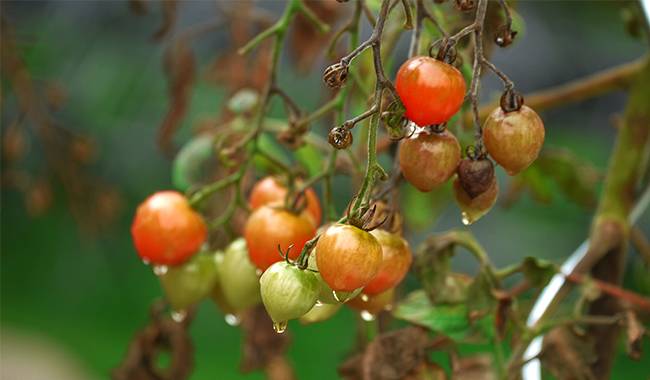
FUNGAL INFECTIOUS DISEASES OF TOMATOES
Fungal diseases are caused by a group of pathogenic fungi. Once the pathogenic microflora is in the right conditions, it begins to flourish and develop, affecting nearby growing plants. Within 1-3 days, the fungus can completely destroy the tomato crop. Harmful fungi are enhanced by the fact that they can affect the entire plant, including the root system, at the same time.
The most harmful fungal diseases of tomatoes include the following.
- Phytophthora.
- Fusarium Wilt.
- Root and root rot and fruit rot.
The main sources of infection are planting material (untreated seeds, diseased seedlings) and soil.
Phytophthora
If infected, the disease can destroy tomato production within 2-3 days, regardless of growing conditions (open field, greenhouse, greenhouse). Phytophthora is also known as brown rot.
It first appears on the lower leaves. It causes discoloration of some areas on the lower side of the leaf disc, which gradually merges into a single spot. In the brown areas, the pathogenic mycelium appears as powdery patches that eventually germinate to the upper part of the leaf disc.
Tomato leaves shrivel, turn yellow, and curl, and leaf tissue begins to necrosis. Petioles and stems are covered with oblong black spots that become necrotic information. The disease spreads to the inflorescence and ovary, gradually turning black and drying out. Fruit tissues become coarse, brown inside, and rotten. Seeds and fruits become unusable.
Do not confuse Phytophthora with powdery mildew. In powdery mildew, there are no brown spots of necrotic tissue.
Infection usually begins in wet, cold weather (early August) or excessively wet in the presence of temperature changes. The pathogen overwinters on the leaves of the plant or in the soil. In spring, residues of Phytophthora spores and mycelium are dispersed by wind and water.
Measures to control Phytophthora
Phytophthora is considered to be a potato fungus. Therefore, you should never plant these crops next to each other in a crop rotation or use potatoes as a precursor to tomatoes.
Spray Bordeaux mixture 2 weeks after sowing tomatoes or when 2-3 true leaves are formed in unplanted crops. Spray also at the first manifestations of the disease.
Chemicals can be used to treat plants: Infinito (a modern fungicide for Phytophthora), etc. One or two sprays are sufficient to kill the disease. However, chemicals can be used at least 30 days before harvest. On private farms, chemical agents are not acceptable.
It is better to use bio fungicides: myclobutanil, bacteriocin, trichothecene, Ampicillin, etc., for an environmentally friendly harvest. These biological agents can be used throughout the growing season until the tomatoes are harvested. They are not harmful to human health. To not addict the plant to the drug, it is better to alternate the biologicals or prepare a tank mixture. For each biological preparation, there is a brochure or advice on the time, method, optimal temperature conditions, dosage, and stage of treatment of plants and soil.
Fusarium Wilt of Tomato
Fusarium Wilt is caused by a soil fungus that affects the root system of plants. The main manifestation of the disease is similar to the lack of water supply to the plant. The plant wilts, then the underlying stem turns dark brown to black, and cracks appear.
The disease progresses to the above-ground parts and first affects the lower leaves of the tomato plant. They become light green and yellowish, and the lamellar veins of the leaves become bright. Gradually, the fungal mycelium creeps up the deformed petioles and stems and takes overall healthy parts of the tomatoes. During this time, pink scum appears on the root necks of diseased plants. Fusarium Wilt is most typical during flowering and fruit formation in tomatoes.
Remember! A telltale sign of Fusarium Wilt infection is the appearance of pink scabs on the root necks of the plants.
The pathogen in the soil overwinters in diseased leaves and fruits. fusarium Wilt actively develops in the presence of increased humidity and sudden temperature changes. The infection penetrates through irrigation, contaminated soil, and dirty tools.
Treatment against Fusarium Wilt of tomatoes
As with phylloxera in tomatoes, strict adherence to agrotechnical requirements, especially those related to irrigation and fertilization, is necessary. The same chemicals as those used for phylloxera can be used.
Since the disease most often affects mature plants, chemical agents should be excluded from the list of protective measures or used only in the early stages. It is best to spray tomatoes with preparations containing copper (copper sulfate or Bordeaux mixture). Among the biological agents, the most active against Trichoderma is Phytophthora-M.
Control measures against Phytophthora and Fusarium Wilt and other fungal diseases include observance of crop rotation and disinfection of seeding material and seedlings with a working solution of Phytophthora-M. Soil should be soaked with Trichodermin (antifungal metabolites from several fungi), etc., 1-2 weeks before planting/sowing.
Dig the soil to 6-8inch (15-20 cm). Before sowing, additionally, apply a bio fungicide solution or 1-2 tablets of adhesive in a 0.4inch (1cm) layer to each hole. Treat plants with the same solution during the vegetative stage according to the recommendations on each package.
Tomato rot. Root and Root Rot
Tomato root and root rot are caused by several groups of fungal pathogens. The main sources of infection are soil, humus piles, and non-sterile substrates in the greenhouse. The rapid spread of the disease is associated with over-watering. As a result, the root system and the root neck area are affected. The disease begins in seedlings and persists throughout the growing season if the agrotechnical requirements are violated.
The main symptoms of root and root rot.
- Focal wilting of the plant, especially in case of excessive watering.
- Changes in color and concentration of root tissue and root neck area.
In tomato seedlings, a thin overgrowth appears under the cotyledons, in older seedlings – under the first pair of true leaves. The effects of rot are manifested by darkening (black legs), thinning, and rotting of the roots and root zone (rhizomatosis, or white legs). Root growth in tomatoes is limited to the central shoot, with no lateral roots or thick roots. The roots are easily pulled out of the soil. Stems in the root zone turn brown and have a cinder-like texture. Cross-sections of tomato stems show brownish-red rings of diseased conducting vessels.
The telltale sign of root rot is hyperextension of the root neck and a change in the natural color of the root. The roots are on a rod without lateral roots and have cobwebby or white felt-like markings on the root neck.
Tomato fruit rot. Tomato root rot or symphytosis
Some rot groups cause both root and stem rot, which affects the leaves and passes to the fruit. Rot spots are not always a sign that the plant is infected. For example, the major infestation of tomato root tip rot is a non-infectious disease. Its appearance is associated with extreme environmental conditions (combination of high temperatures and low humidity), violation of agrotechnical requirements (excess nitrogen), and is accompanied by destruction of tomato fruit tissue. The lesions appear on the brushes that form the fruit. Concentric brown spots usually appear at the apex (tip) of green and ripe fruits and less frequently at the pedicel area. These spots can be depressed or flat. They increase in size and undergo necrosis or softening and decay of tissues.
Non-infectious diseases are also fruit dehiscence (along with the fruit) and “heifer’s smile” or “cat face” (usually across the fruit) when the upper part of the ground is healthy. Cracking is associated with uneven irrigation, excessive nitrogen fertilization, and improper application of stimulants (high concentrations).
The pathogenic asexual fungus penetrates into the open fruit tissue and causes secondary infection of the plant. Most commonly, plants are indirectly infected with Alternaria, which is known as macrosporidiosis or dry spot disease. Conidia of the trophozoite fungus penetrate the inside of the fruit through cracks and rotten areas, forming a fungus that looks like a fluffy patch. The conidia and fungal hyphae stain the black spots on the fruit black. Diseased fruits fall off and become a source of soil contamination by the disease-causing fungus.
Measures against Alternariosis (i.e., tomato root-tip rot)
To protect the fruit of the crop from Alternaria and other fungal infections, it is necessary to suppress the attack of tomato root-tip rot. Apex rot is caused by insufficient watering (soil is too dry) and insufficient calcium supply due to an imbalance of nutrients in the feed.
A single application of compound fertilizer does not eradicate the cause of the disease. It is necessary to spray the plants regularly, according to the fertilizer program under tomato wood ash, with an infusion of wood ash (1-2%) or a special product containing calcium, boron, phosphorus, potassium, nitrogen, magnesium, and other nutrients. You can use Brexit Ca for fertilization (10 g/2.5 Gal water at 10-15 day intervals). Apply a calcium nitrate solution (10 g/2.5 Gal water) under the roots after watering, or spray the plants with it (5 g/2.5 Gal water), keeping a one-week interval.
When treating the above-ground parts of tomato plants, it is safest to use bio fungicide preparations. Treatment with them can be carried out until harvest. Use the same biological agents as used for Phytophthora, Fusarium Wilt, and other fungal diseases. To reduce the number of treatments, it is best to prepare tank mixtures for different fungi and spray the plants using a soil treatment system (by irrigation with a biological solution) and at 7-15-20 day intervals throughout the vegetation period before harvest.
Other types of tomato fruit rot
In addition to root tip rot, tomatoes are also affected by other types of fruit rot. With improper watering, nitrogen-rich nutrition, and planting of diseased seedlings, tomato fruit can be affected by wet rot, including soft rot, which is characterized by watery internal tissues with a fermented acidic odor, and pus rot, in which the fruit resembles a water balloon and is partially covered with fluffy white patches.
Black masses on the tomato fruit where the stalk joins the fruit sign that the fruit is infested with black mold. Ripe fruits become watery and soft after a short storage time – the first sign of hard (Rhizoctonia) rot turning soft and watery.
Prevention and treatment of tomato rot
If tomato fruits get the sympathetic disease, as well as other rots: anthracnose, septicemia, phoma, etc., the plants can be protected with chemical fungicides, picking up the preparation and waiting for a short time.
These compounds include Quadris (fungicide combining coccolithophores and triazole active ingredient) (12 ml/2.5 Gal water), treating the plants 3 times during the season, but no later than 30-35 days before fruit ripening.
Ridomil Gold (which is a super active granular fungicide) (0.25% solution) can stop the disease in case of mass development. In addition, its waiting period is only 14 days. A solution of Metalaxyl (which is a systemic fungicide) is effective.
If there are few tomatoes on the plot, soil treatment with Previcur (which is a systemic fungicide) solution at planting/seeding will help to control root rot. Treatments should be repeated 2-4 times throughout the growing season.
To prevent Rhizoctonia, treat the soil with a suspension (0.3%) containing sulfur preparations, including colloidal sulfur.
To increase resistance to rot, it is effective to fertilize plants with the drug “Drop” (2 tablespoons per 2.5 Gal of water) at a rate of 0.25 Gal (1 liter) solution under the bush before flowering. The nutrition of plants with trace elements and herbal infusions according to folk recipes is also necessary.
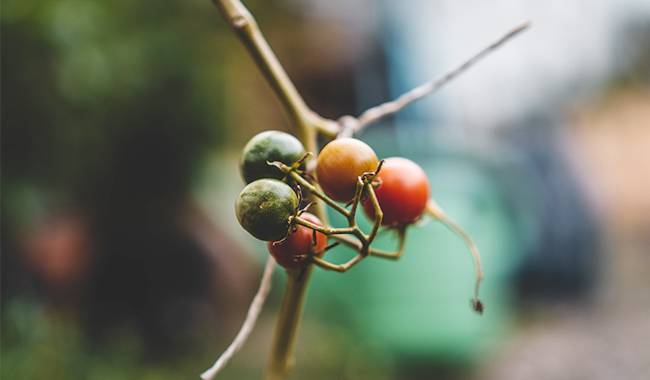
TOMATO VIRAL DISEASES
Among the viral diseases of tomato, the best known in the open and closed ground is tobacco mosaic virus, tobacco necrosis virus, leaf curl virus, streak. Widely distributed are mainly Mosaic and STRICK.
Tobacco mosaic virus
Tobacco mosaic virus manifests itself as discoloration of tomato leaflets (a mosaic pattern of irregularly shaped light and dark spots). Leaves become pale, curled, and wrinkled. The leaves and bushes as a whole are stunted and yellow in color. A small group of small, hard-to-eat fruits can be formed.
B. Tomato Necrotic Streak Virus
Tomato Necrotic Streak Virus affects the above-ground organs of tomatoes. The disease manifests as oblong brown or brownish-red necrotic streaks on stems and petioles. Needle-like spots appear on tomato leaves, which dry out and become brittle over time. Petioles break easily, and fruits have brown furrows, sometimes shiny and irregularly shaped.
PREVENTION AND CONTROL OF VIRAL DISEASES OF TOMATOES
Violation of nutrient ratios, high nitrogen content, and humidity accelerate the defeat of tomato bushes and the spread of viral diseases. The fight against viral diseases lies in preventive measures.
- When sowing seeds, always use zoned, disease-resistant tomato varieties and hybrids.
- It is best to use 2-3-5-year-old sowing material.
- The source of infection remains in the seed. Therefore, tomato seeds must be disinfected before sowing. If no special preparation is available, incubate the seeds in a 1-2% solution of manganese for 15-20 minutes.
- Water the soil with a 2% solution of manganese before sowing or planting seedlings. On the day of sowing, add a mixture of trichloromethane or phytosporin solution with rhizobium to the hole or row.
- There is no treatment for virus infection. Tomato bushes are uprooted and burned. They must not be used for composting. Disinfect the area where the plant is located with a 2-3% solution of manganese or chlorolime by other methods (protection of the soil).
BACTERIAL INFECTIONS IN TOMATOES
The soil is literally stuffed with different kinds of infections carrying soil fungi and bacteria. It is impossible to get rid of the infection completely, but with the right protection, you can maintain a positive balance between the necessary and negative microflora in the soil. It is often the case that the anti-fungal measures taken still provide effective protection.
The plant has recovered, is successfully forming young leaves, young inflorescences have appeared, and suddenly there is a new outbreak of the disease. This time, however, the symptoms of the disease did not resemble those of a fungal or viral infection. The niche proved to form a bacterial infection that could quickly affect all plants in a large area.
The most vicious diseases are bacterial diseases.
- Bacterial tomato wilt.
- Bacterial black spot disease.
To a lesser extent, tomatoes are affected by bacterial cancer and other bacterial infections.
Bacterial wilt of tomatoes
The disease starts on the lower leaves of tomatoes and spreads rapidly to the entire plant. The leaves lose their luster and droop without visible changes. In the chronic form, longitudinal brown streaks can be seen under the epidermis of the stem. Many aerial roots form throughout the tomato’s stem in an immature state.
When pressed, bacterial cloudy exudate exuded from the damaged stems, and cross-sections clearly showed brownish rings of lesioned blood vessels. In fruit, the lesioned tissue turns brown on the outside and becomes denser on the inside. If the plant is severely affected, even the seeds can become diseased.
Tomato wilt is characterized by overhanging wilted leaves with no color change, secretion of cloudy mucilaginous exudates, and aerial roots appearing in a rudimentary state.
Prevention and treatment of bacterial wilt of tomato
Control of bacterial infection is based on the precautions described in the section on fungal and viral diseases above.
It is recommended to disinfect tomato seeds and treat seedlings with a tank mixture including preparation of “copper humate” before sowing and before flowering. Diseased plants can be treated with a 0.02% solution of quinazoline. It is more practical to treat soil and plants with biological agents from the time vegetation begins until harvest.
Keep in mind that using the preparation on heavily affected tomatoes will not provide bright results, but will help maintain strong plants and partially cleanse the soil of bacterial infection. For this reason, the soil should be treated with 0.2% phytobase, phytase, after removing diseased plants.
These antibiotics will blunt the rate of infection. After a week, repeat the soil treatment with a 0.2% disinfectant solution. As recommended, plants can also be treated with the same solution.
Most commonly, bacterial damage in tomatoes is targeted with bio fungicides such as BACTOFIT, which inhibit more than 60 soil pathogens. Of particular value is the fact that these biological agents are also active against fungal infections.
Black bacterial spot of tomato
The bacterial black spot of tomato is one of the most harmful diseases, which quickly develops into an epiphytic infestation under the best weather conditions. This disease is terrible because it affects the entire plant, starting with the root system. The disease begins on young tomato leaves with small, indeterminate brown spots.
The small spots proliferate and merge into large spots, which is highlighted by a darkened spot. These spots are necrotic. The leaves, stems, and petioles of tomatoes gradually turn black, curl, and fall off. On tomato fruit, black bumps with watery margins grow into festering circular formations and ulcers.
Black bacterial spot disease is characterized by blackening the center of the spot on tomato leaves, followed by tissue necrosis.
The disease develops intensively at high temperatures. At lower temperatures, the disease dies out, but the pathogen remains alive while waiting for the right climatic conditions. The viability of the pathogen lasts for a long time. Seeds spread the disease.
Measures to prevent and control black fungal disease
When growing tomatoes, all agronomic measures must be implemented. Preventive measures to prevent infection are the most effective. The preparations used to protect plants from bacterial infections are the same as those used for the above-mentioned infections. The treatment of the soil, vegetative parts of the plant, and the fruit are carried out rationally by means of tank mixtures. This will reduce the number of treatments and improve their effectiveness.
The characteristics of some of the most prevalent fungal, bacterial and viral diseases of tomatoes are described herein. Using the presented preparations for eradication of the described diseases, it is possible to suppress the spread of some related (undescribed) infectious diseases and to obtain healthy fully grown crops.
More related information about growing tomato plants




